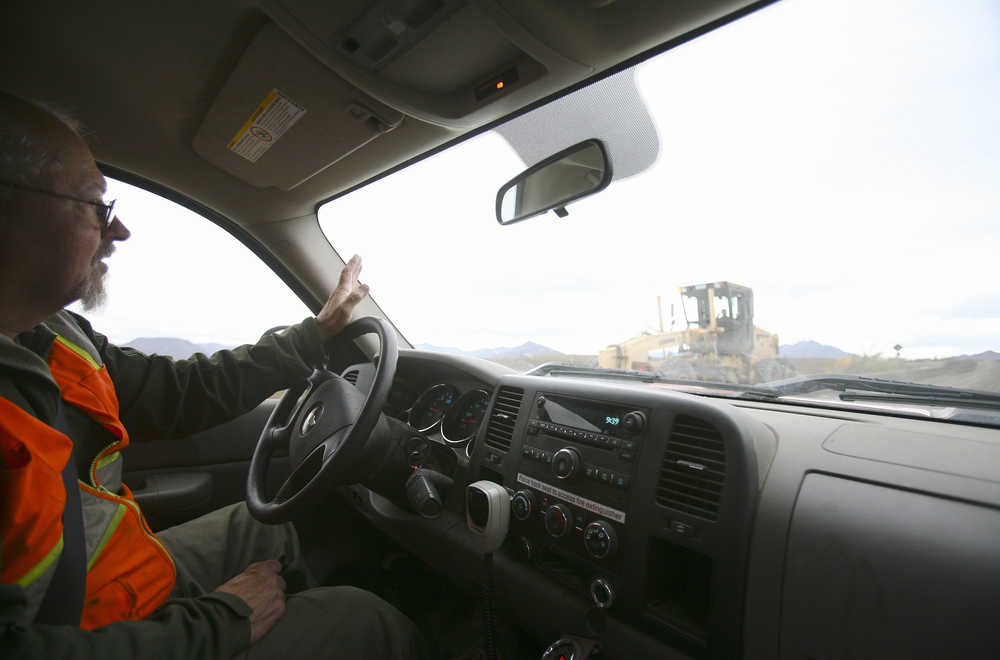FAIRBANKS — The workers on the Denali National Park and Preserve road crews spend their time navigating a narrow path between two imposing bodies.
In the most literal sense, the road crew spends every day maintaining the narrow, two-lane road that runs for miles between 6,000-plus foot ridge lines, but in a more figurative sense, the road crews are perpetually toeing the line between resource protection and visitor access.
Tasked with the maintenance of a 92-mile road through the heart of the national park, the Denali Park road crew stays busy.
Excluding the first few miles, from its start to the Savage River where personal vehicles cannot pass, most of the park road is unpaved. The miles of gravel road require constant work — whether that means laying down calcium chloride to prevent choking clouds of dust, reclaiming the road banks to stop the road’s gravel edges from inching out into the tundra or grading the slope of the bumpy road to make it passable for the 10,000 buses that will travel its length annually.
All of this work falls on the shoulders of the road crew — a couple dozen men and women who spend day after day ensuring the park’s thousands of visitors have a place to go when they arrive.
The road crew is split into two groups that occupy and maintain their separate and bordering territories: the western crew, which roves from the park entrance up to Sable Pass at 39 Mile on the park road, and the eastern crew, which picks up where the western crew leaves off at Sable Pass and runs to Kantishna at the terminus of the park road.
Since Sable Pass and beyond is typically accessible only by bus, many visitors don’t always make it that far into the park. Everyone who enters the park via the road system must pass through the domain of the western road crew — led by Rick Weibel.
Weibel has been maintaining the Denali Park Road for nearly 30 years. He started with the park’s eastern road crew as a seasonal rock crusher operator in the 1980s and after a minor excursion or two away from the park, his career has largely paralleled the unique highway.
He plans to retire this fall. When the inevitable cessation of summer forces the closure of the park road and the animal residents cease their winter preparation, Weibel, too, will take his leave of work. For the remainder of the season, however, he and his crew will work nonstop to finish the pile of work that must get done before winter.
Weibel’s road crew struggles to keep the park road functional, often without much outside recognition. Some of the attention that does make its way to the road crew, though, doesn’t come in the form of thanks, as some detractors have pointed to the park road’s very existence as a destructive property.
“There’s a school of thought that says this road shouldn’t even be here,” he said. “Parks have two mandates, to protect the resources and to provide for the enjoyment of the public. … I guess it basically boils down to an individual opinion.”
In Weibel’s description, that balance is more like a pendulum that swings slowly back and forth between increased resource management or expanded public access. The motion of that pendulum depends on numerous factors, from the attitude of the park superintendent to changes in federal regulation.
“There’s a tension between resource group and maintenance. I think it’s always going to be there,” Weibel said. “There’s a dynamic tension that ultimately management has to decide what’s really in the best interest of the park and in the best interest of the public.”
Weibel said it’s possible the road crews are sometimes painted as villains or antagonists of wilderness preservation, but one thing he said many people fail to recognize is that he and his team are there for the same reason as the park rangers and scientists and visitors.
“One thing that sometimes strikes us as maintenance people is that the resource people think they care about the park more than we, and that’s not really the case,” he said. “Everybody here is trying to do their part to either protect the resource or provide for the public or somewhere in between.”
The road crew, in Weibel’s view, is not some destructive force sent to defile a 92-mile stretch of pristine wilderness but rather a valuable agency tasked with providing a connection between that wilderness and the generations of people for whom it has been preserved.
“Do you want to make this a place where people come and have an enjoyable experience, or do you want to make this a place that’s a glass jar that no one steps into?” he said.
For Weibel and his road crew, the goal is to allow visitors the chance, however limited, to glance into that glass jar.

